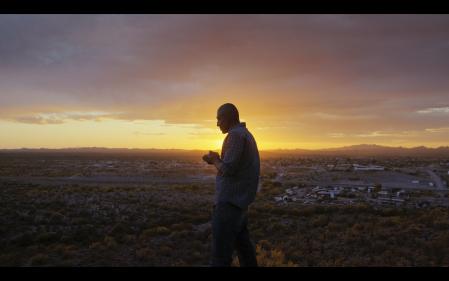A different view of immigration and a look at the Tohono-Outham people

For a few years, the issue of Mexican and Central American immigration seeking to come to the United States to realize the so-called “American Dream” has become a constant within cinema made in Mexico with a large number of productions dealing with it in different forms, although always in a very similar style. . With his fifth documentary film, Shadow of the Desert (or Lost Paradise)Mexican director Juan Manuel Sepulveda He takes an approach towards immigrants in a slightly different way than we are used to in other similar films and now it’s all ready for us to see on the big screen from December 3.
The director graduated from the National School of Cinematic Arts (ENAC) of UNAM, and spoke with him Fact Scenario About his new film, which tells a non-fiction story set on an increasingly militarized frontier, as Mexicans and Central Americans attempt to cross a desert in which thousands of people have died pursuing the same goal they pursue; In addition to being the scene of the phenomenon of migration, that same region is home to another Tohono O’othamThe people of the desert who resist and they are on the verge of fainting.
“The desert allowed us to match these two stories of nomadism because in the end the film becomes a wonderful portrait of the nomads of the two forces that cross the desert in it, on the one hand, the indigenous people of Tohono O’otham and beyond on the other hand, on the other hand, the Mexican and Central American immigrants” , began the director, pointing to the place where his new work takes place, that desert in which the border between Mexico and the United States is located, which is one of the most intersecting deserts not only in contemporary history, but in distant history in general.
“Since my first film, the issue of immigration has become very present and from that moment I realized that there are two main views about immigration, on the one hand there is the vision of the state that is increasingly oppressive and violent and criminalizes the immigrant, and on the other hand, there is a world-saving vision that decides that the immigrant is an unjust victim Capable of anything that needs rescuing,” he said.
Still image from his latest movie The Shadow of the Desert (or Paradise Lost).
“From this first film I tried to begin to break away from both visions and create a vision that would depict the complexity of human beings who have been through so much pain and hope as all people because we are all migrants at the end of the day, because if we don’t come from our country we go somewhere else.”
“Consistent with the stream of these visions is a constant throughout my work and in desert shadow No exception, in fact, in this film, I go a little further by trying to remove this economic burden from the immigrant in the sense that it is not just an economic exile seeking to make money, there is a more existential aspect to the fact of crossing that desert” the director commented on his interest in the topic of immigrants For his portrayal on the screen in his movie so far, which is repeated in his new movie.
At the same time we know the various stories of migrants on their perilous passage through the desert to reach their desired destination, we also know the rest of the Tohono-Outham people, who are increasingly seeing their population dwindle and their language is that they are losing, most of them no longer living in the desert because they have gone to look for Better living conditions in neighboring cities.

Cineteca Nacional presents his work in a retrospective.
“The reason I came to the desert is because I read that there is a bi-national ethnic group who is directly opposed to the militarization of the border between Mexico and the United States, and the construction of a wall that divides the desert in two, they tell me that I am approaching the community and they welcome me to tell me not only the story of the wall, which is the least of their problem, But also to tell me their story of the constant resistance to developing a certain way of life. That the desert is infinite and you cannot isolate it, they tell me that there will always be a place they can cross because they know that desert very well, they know it better than the authorities and a lot”, the director shared about his experience when photographing life Daily On Screen Tohono O’otham.
Regarding his way of portraying immigrants in his new film, the director also told us that on this occasion he also gave them a certain metaphysical aspect by connecting them to the characters in John Milton’s poem, Paradise Lost, an epic in which an army of fallen angels try to reclaim their lost paradise.
Juan Manuel Sepulveda will premiere Shadow of the Desert (or Lost Paradise) In state theaters in the same way this film will be part of a retrospective dedicated to the director, organized by the Cineteca Nacional and taking place in Mexico City, Guadalajara and Monterrey from November 30 to December 3.
“It is a great honor that an organization like Cineteca, where I have trained like so many colleagues and movie-goers in this country, gives me a retrospective, it is a dream and at the same time also means a lot of responsibility because Cineteca is betting on a cinema that has always tried to turn the tide, and that it has tried not to Being satisfied with formulas that work and that aspire to generate a critical vision of reality does not necessarily align with what is politically correct, which means that we must continue to make this cinema,” concluded the director, referring to how he feels now after choosing seven titles from his cinematographic films to screen in A special course.

“Professional problem solver. Subtly charming bacon buff. Gamer. Avid alcohol nerd. Music trailblazer.”




:quality(75)/cloudfront-us-east-1.images.arcpublishing.com/elcomercio/6NEH6FMKYBCU7JJWZ5GVRZKTRM.jpg)
/thumbs.vodgc.net/1-14-FnXFWZ1684253239488_1080P.jpg)





